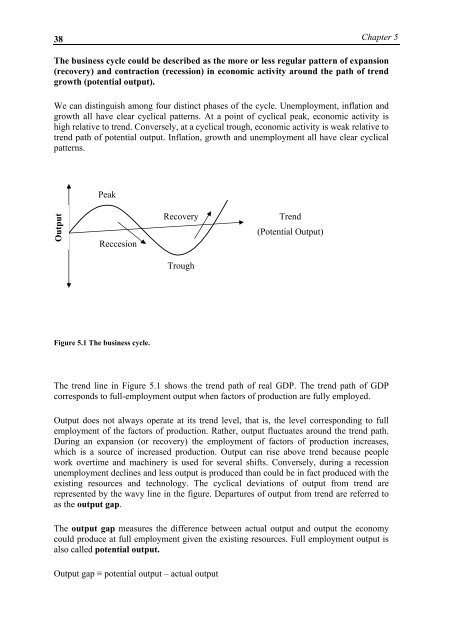MacroeconomicsI_working_version (1)
Create successful ePaper yourself
Turn your PDF publications into a flip-book with our unique Google optimized e-Paper software.
38<br />
Chapter 5<br />
The business cycle could be described as the more or less regular pattern of expansion<br />
(recovery) and contraction (recession) in economic activity around the path of trend<br />
growth (potential output).<br />
We can distinguish among four distinct phases of the cycle. Unemployment, inflation and<br />
growth all have clear cyclical patterns. At a point of cyclical peak, economic activity is<br />
high relative to trend. Conversely, at a cyclical trough, economic activity is weak relative to<br />
trend path of potential output. Inflation, growth and unemployment all have clear cyclical<br />
patterns.<br />
Peak<br />
Output<br />
Reccesion<br />
Recovery<br />
Trend<br />
(Potential Output)<br />
Trough<br />
Figure 5.1 The business cycle.<br />
The trend line in Figure 5.1 shows the trend path of real GDP. The trend path of GDP<br />
corresponds to full-employment output when factors of production are fully employed.<br />
Output does not always operate at its trend level, that is, the level corresponding to full<br />
employment of the factors of production. Rather, output fluctuates around the trend path.<br />
During an expansion (or recovery) the employment of factors of production increases,<br />
which is a source of increased production. Output can rise above trend because people<br />
work overtime and machinery is used for several shifts. Conversely, during a recession<br />
unemployment declines and less output is produced than could be in fact produced with the<br />
existing resources and technology. The cyclical deviations of output from trend are<br />
represented by the wavy line in the figure. Departures of output from trend are referred to<br />
as the output gap.<br />
The output gap measures the difference between actual output and output the economy<br />
could produce at full employment given the existing resources. Full employment output is<br />
also called potential output.<br />
Output gap ≡ potential output – actual output




